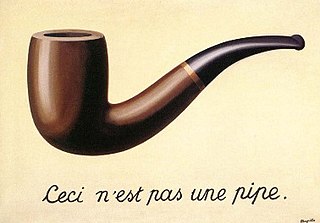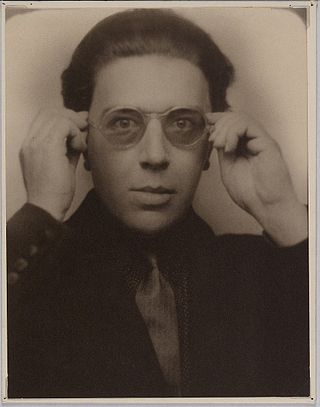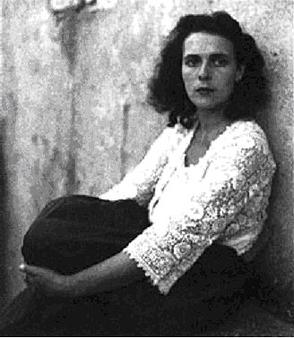
Dada or Dadaism was an anti-establishment art movement that developed in 1915 in the context of the Great War and the earlier anti-art movement. Early centers for dadaism included Zürich and Berlin. Within a few years, the movement had spread to New York City and a variety of artistic centers in Europe and Asia.

Surrealism is an art and cultural movement that developed in Europe in the aftermath of World War I in which artists aimed to allow the unconscious mind to express itself, often resulting in the depiction of illogical or dreamlike scenes and ideas. Its intention was, according to leader André Breton, to "resolve the previously contradictory conditions of dream and reality into an absolute reality, a super-reality", or surreality. It produced works of painting, writing, theatre, filmmaking, photography, and other media as well.

André Robert Breton was a French writer and poet, the co-founder, leader, and principal theorist of surrealism. His writings include the first Surrealist Manifesto of 1924, in which he defined surrealism as "pure psychic automatism".
Juxtapoz Art & Culture Magazine is a magazine created in 1994 by a group of artists and art collectors including Robert Williams, Fausto Vitello, C.R. Stecyk III, Greg Escalante, and Eric Swenson to both help define and celebrate urban alternative and underground contemporary art. Juxtapoz is published by High Speed Productions, the same company that publishes Thrasher skateboard magazine in San Francisco, California.
The Surrealist Manifesto refers to several publications by Yvan Goll and André Breton, leaders of rival surrealist groups. Goll and Breton both published manifestos in October 1924 titled Manifeste du surréalisme. Breton wrote a second manifesto in 1929, which was published the following year, and a third in 1942.

Massurrealism is a portmanteau word coined in 1992 by American artist James Seehafer, who described a trend among some postmodern artists that mix the aesthetic styles and themes of surrealism and mass media—including pop art.

Lowbrow, or lowbrow art, is an underground visual art movement that arose in the Los Angeles, California area in the late 1960s. It is a populist art movement with its cultural roots in underground comix, punk music, tiki culture, graffiti, and hot-rod cultures of the street. It is also often known by the name pop surrealism. Lowbrow art often has a sense of humor – sometimes the humor is gleeful, impish, or a sarcastic comment.

Meret Elisabeth Oppenheim was a German-born Swiss Surrealist artist and photographer.

Anti-art is a loosely used term applied to an array of concepts and attitudes that reject prior definitions of art and question art in general. Somewhat paradoxically, anti-art tends to conduct this questioning and rejection from the vantage point of art. The term is associated with the Dada movement and is generally accepted as attributable to Marcel Duchamp pre-World War I around 1914, when he began to use found objects as art. It was used to describe revolutionary forms of art. The term was used later by the Conceptual artists of the 1960s to describe the work of those who claimed to have retired altogether from the practice of art, from the production of works which could be sold.

In society, the term low culture identifies the forms of popular culture that have mass appeal, often broadly appealing to the middle or lower cultures of any given society. This is in contrast to the forms of high culture that appeal to a smaller, often upper-class proportion of the populace. Culture theory proposes that both high culture and low culture are subcultures within a society, because the culture industry mass-produces each type of popular culture for every socioeconomic class. Despite being viewed as characteristic of less-educated social classes, low culture is still often enjoyed by upper classes as well. This makes the content that falls under this categorization the most broadly consumed kind of media in a culture overall. Various forms of low culture can be found across a variety of cultures, with the physical objects composing these mediums often being constructed from less expensive, perishable materials. The phrase low culture has come to be viewed by some as a derogatory idea in and of itself, existing to put down elements of pop or tribal culture that others may deem to be "inferior."

Fantastic art is a broad and loosely defined art genre. It is not restricted to a specific school of artists, geographical location or historical period. It can be characterised by subject matter – which portrays non-realistic, mystical, mythical or folkloric subjects or events – and style, which is representational and naturalistic, rather than abstract – or in the case of magazine illustrations and similar, in the style of graphic novel art such as manga.

Mary Leonora Carrington was a British-born, naturalized Mexican surrealist painter and novelist. She lived most of her adult life in Mexico City and was one of the last surviving participants in the surrealist movement of the 1930s. Carrington was also a founding member of the women's liberation movement in Mexico during the 1970s.
Emma Frith Bridgwater, known as Emmy Bridgwater, was an English artist and poet associated with the Surrealist movement.
Dau al Set, the first post-World War II artistic movement in Catalonia, was founded in Barcelona in September 1948 by poet Joan Brossa. The movement, best known for translating the conscious and unconscious mind into art, was heavily influenced by both the Surrealist and Dadaist movements. In Catalan Dau al Set means "the seventh face of the dice", which expresses the movement's rupturist character.
The Bureau of Surrealist Research, also known as the Centrale Surréaliste or Bureau of Surrealist Enquiries, was a Paris-based office in which a loosely affiliated group of Surrealist writers and artists gathered to meet, hold discussions, and conduct interviews in order to "gather all the information possible related to forms that might express the unconscious activity of the mind." Located at 15 Rue de Grenelle, it opened on 11 October 1924 under the direction of Antonin Artaud, just four days before the publication of the first Surrealist Manifesto by André Breton.
The Birmingham Surrealists were an informal grouping of artists and intellectuals associated with the Surrealist movement in art, based in Birmingham, England from the 1930s to the 1950s.
Surrealist cinema is a modernist approach to film theory, criticism, and production, with origins in Paris in the 1920s. The Surrealist movement used shocking, irrational, or absurd imagery and Freudian dream symbolism to challenge the traditional function of art to represent reality. Related to Dada cinema, Surrealist cinema is characterized by juxtapositions, the rejection of dramatic psychology, and a frequent use of shocking imagery. Philippe Soupault and André Breton’s 1920 book collaboration Les Champs magnétiques is often considered to be the first Surrealist work, but it was only once Breton had completed his Surrealist Manifesto in 1924 that ‘Surrealism drafted itself an official birth certificate.’

Women Surrealists are women artists, photographers, filmmakers and authors connected with the surrealist movement, which began in the early 1920s.
The Generation of the '30s was a group of Greek writers, poets, artists, intellectuals, critics, and scholars who made their debut in the 1930s and introduced modernism in Greek art and literature. The Generation of the '30s is also cited as a social movement. The previous Medieval and post-Byzantine Greek eras, which glorified religion, Jesus, and the certainty of Enlightenment thinking, were rejected by modernism. Elements of surrealism and utopianism were introduced in efforts to renew contemporary literature. Most notable among the Generation of the ‘30s is Giorgos Seferis, a Greek poet of the 20th century who instigated the turning point into modernity with surrealism in his poetry. After the Balkan Wars and the disastrous Greco-Turkish War of 1922, literature could no longer boast nationalistic aspirations of the previous generation. Thus, there was a need to establish a new dogma, or Greekness (Ελληνικότητα), that would aestheticize Hellenocentric opinions, attitudes, and symbols, and foster a new national identity. The Generation of the ‘30s enacted this by publishing various art and literature that were autonomous from other foreign models, and institutionalized modern literature to open up new perspectives and explore new ways to understand Greekness.
Kamel el-Telmissany (1915-1972) was an Egyptian artist and filmmaker most commonly associated with the Cairo-based Art et Liberté Group. He was one of the group's founding members along with Georges Henein and Ramses Younan. His nephew is the famed Egyptian cinematographer Tarek el-Telmissany.










